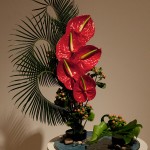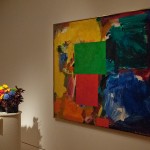Art in Bloom Shines at the Cincinnati Art Museum
A Personal Essay
By Laura A. Hobson
For a pleasant journey to soak in flowers matching art masterpieces, I stopped by the Cincinnati Art Museum on November 7 to enjoy the opening of the seventh annual Art in Bloom show where professional and amateur florists chose pictures to represent in flowers. On both the first and second floors, I saw excellent examples of matches that the florists depicted.
Opening the exhibit was the famous “Undergrowth with Two Figures” done by Vincent Van Gogh in 1890 matched by a stunning purple and yellow arrangement done by Brenda Baird. She was able to portray the texture, colors and depth of field in her submission.
Of the 60 exhibits, there were professional and amateur florists. One of the professional florists is Dennis Buttlewerth, who has his own shop in O’Bryonville and has exhibited in the White House. One piece he chose to interpret was the “Henry Marvin Magill Memorial Window,” a Tiffany window created c. 1900. His simple, almost modernistic, design portrayed an angel between two worlds. There were blown glass containers to match the verticality of the windows, a gold dish to represent the halos and bright flowers to pick up the colors in the window. While not the most interesting display in the show, it was intriguing.
In a totally different style is the “Slave Market” by Jean-Leon Gerome done in 1871. Amateur florists Kim Chamberland and Betsy Anderson chose this piece to interpret because they wanted the challenge of the concept of slavery. The picture shows the owner and slaves at his feet in the Middle East. To demonstrate the slavery, the women chose a trap. Men’s ties at the foot of the design represent not only the rugs, but also the fact that man is still involved in slavery. The women are members of Lily of the Valley Garden Club in Milford.
The ever popular Paul Gaugin painted the brightly colored “Mahana Ma’a” in 1892. Amateur artist Ellen Foley matched the painting with ferns, birds of paradise in bright oranges and greens. You have the feeling you’re in Tahiti when you look at both.
In their first attempt of entering the show, Karen Reynolds and Lisa Collins interpreted “The Bridge at le Pecq” painted by Andre Derain, who lived from 1880 to 1954. They chose the painting for its vibrant colors. Meeting in a painting class at Scarlet Oaks, Karen and Lisa enjoyed the process of creating a match with deep brush strokes and Fuji mums painted dark blue.
The popular “Red Rooster” by Marc Chagall in 1940 was interpreted by the third grade class of art teacher Jan Wiesner at Summit Country Day. A subdued ceramic village pot glazed in whites and grays, because it was destroyed in WW II, represented Chagall’s Russian village of Belarus that he grew up in and to which he could not return. Art in Bloom strove to match colors as well as lines and shapes within the painting so the children handled the flowers, e.g., red carnations, Fuji mums, white carnations and snap dragons (floating figure above rooster).
Professional florist Robin Wood interpreted “Toward Crepuscule” painted by Hans Hofman in 1963. Bright colors, again, focus this design. Disc jockey turned florist, Robin has managed Robin Wood Flowers since 2001.
Barbara Weyand and Jen Ragland co-chaired this year’s Art in Bloom along with a large committee. Honorees were Natalie B. Rood (deceased), Cincinnati Art Museum volunteer for many years, and Mary Jo Beck, CAM docent. Presenting sponsors were the Oliver Family Foundation and Gorilla Glue.
This is an event I enjoy every year just to see the creativity in which the florists match the paintings taken from the CAM collection.
- Wren Hansen – “Moto Ikebana” – photo by “Image After Photography” John Petric
- Robin Wood Florist – Photo by “Image After Photography” John Petric
- Isaiah Hyman – Christ Church Cathedral Flower Guild – Photo by “Image After Photography” John Petric






